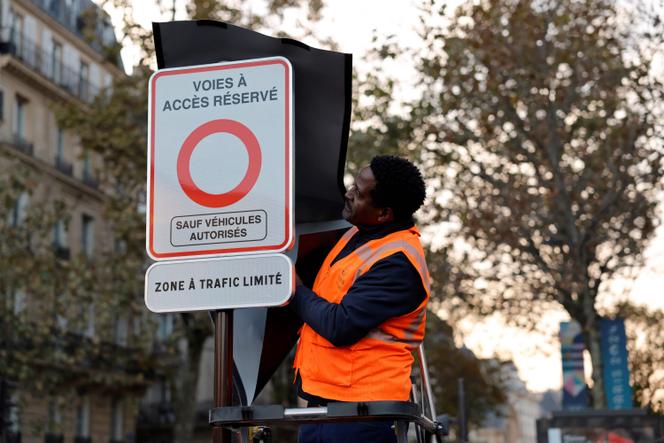


The new road sign was concealed under a large dark cover. At 5 pm on Monday, November 4, at an intersection where the Place de la Bastille connects to the entrance of Rue Saint-Antoine, a thoroughfare leading to the center of Paris, a man, clad in a fluorescent orange vest and safety shoes, climbed the four steps of a gleaming stepladder and took the cover off, revealing a red circle drawn in the middle of a large red-rimmed white rectangle.
Smiles beamed and photos flashed for what was supposed to be solemn moment: The sign indicates the entrance to the city's limited traffic zone (LTZ). It also marks the date, November 5, of the entry into force of this system, which is unprecedented in Paris but widely tested elsewhere, banning all motorized vehicles that do not have a good reason for entering the marked-out perimeter.
"This is the first LTZ in Paris, but not the first in France, nor in Europe. Italy has done it, and now it's our turn. We no longer want the center of the capital to be a shortcut to travel across France and Europe," explained Ariel Weil, the Socialist mayor of Paris Centre (representing the city's central arrondissements), while standing at the foot of the stepladder, alongside three of Paris Mayor Anne Hidalgo's deputies. Around a hundred other panels were set to appear around the cityscape in the process, all stationed at the borders of the 1st, 2nd, 3rd and 4th arrondissements. In addition to the first type of sign, which indicates entry into the zone – which will cover Paris Centre, with the exception of the Ile Saint-Louis and Ile de la Cité islands – another type will warn drivers and motorcyclists they approaching the zone, and a third that they are leaving it.
"There's nothing revolutionary about these signs, they're everywhere in Italy," said Patrick Bloche, Socialist Mayor Hidalgo's first deputy, to put the change into perspective and respond to criticism from the opposition. Indeed, a press release from the Changer Paris opposition group (including right-wing Les Républicains party members, centrists and independents) denounced its "zero environmental impact and the eviction of Parisians in favor of tourists," fearing its effects on businesses.
In 2019, the Environment and Energy Management Agency (ADEME) counted 238 LTZs in operation across eight European countries. Italy alone was home to 228 of them, set up in Rome, Genoa and Milan, as well as in other smaller cities that have sought to preserve their old town centers. In France, Nantes began the movement in 2012, followed by Grenoble, in 2017.
You have 70.99% of this article left to read. The rest is for subscribers only.
